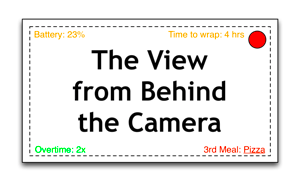
ISO: What Works for You
Since the beginning of film, cinematographers have sought to assign their own speed ratings to film. The same is now true of video cameras. I don’t know how manufacturers do…

ISO: Is It Really What You Think It Is?
Does a camera’s ISO setting actually represent reality? Maybe. Here’s a way to test it using a gray card and a calibrated light meter… It’s important to see if a…

ISO: The Standard that Doesn’t Really Exist
Ever wonder why cameras with the same ISO can look so different? Yeah, me too. There’s no easy answer as to why. When I started out as a young camera…
NAB Show Reports
More Articles & Reviews...
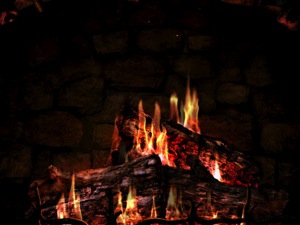
What Firelight and Windows Have in Common
Firelight and window light have a lot in common. They both require multiple light sources to look convincing. Here are my favorite tricks for reproducing both. I first learned the “strips of multicolored gels waved in front of a light” firelight trick in film school, and I never found it very convincing. I don’t get a lot of opportunities to use flame bars, and I know there are ways to emulate firelight using multiple china balls with different gels on them. My favorite technique came about by simply staring into a fireplace for a while.
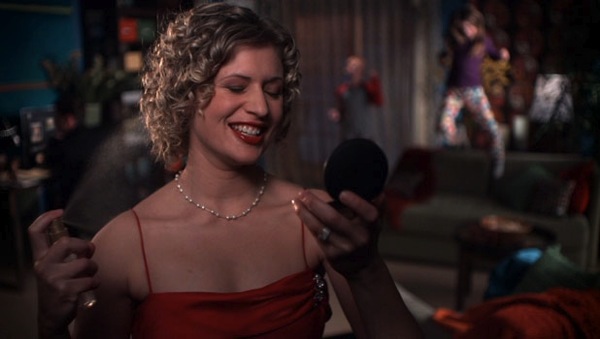
The Joys of Lighting Flat
There’s one place in every set that’s never going to be seen, and that’s directly behind the camera. Light from this direction is generally considered uninteresting but if you have a nuanced eye you can create some really interesting looks by putting a light in the one spot that every film school teaches students to avoid.
Lighting direction is important, but so is the size of the source. A small non-diffused light placed directly behind the camera is generally doesn’t work well because it makes people and things look obviously lit. There are situations where this kind of lighting does work–we see it all the time in older movies when a female star has to look her best–but for modern work it feels a bit forced.
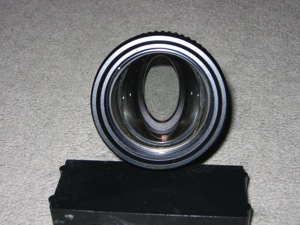
The Pitfalls of Anamorphic
Focus is a huge issue in anamorphic, and everyone on the camera crew has to wrap their heads around which focal length lens does what. For example, in spherical cinematography a 50mm lens delivers a “normal” perspective, but in anamorphic the closest to this is the 80mm. The reason for this is that each anamorphic lens is really two lenses in one: it’s 80mm tall but 40mm wide, for a 2:1 squeeze. A spherical 40mm lens isn’t all that long and focus isn’t that big a deal in the horizontal axis, but the addition of an 80mm lens to the vertical axis cuts depth of field in half. A 40mm spherical lens has reasonable depth of field, but add an 80mm lens into that mix and suddenly you have to pay a LOT of attention just to make sure medium shots are in focus.
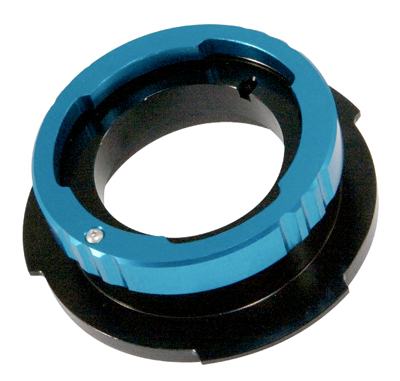
Review: MTF Lens Mount Adapter
Over the past few years, many companies have brought to market lens mount adapters. Some of these adapters are simply machined rings that allow for one type of lens’ flanges…
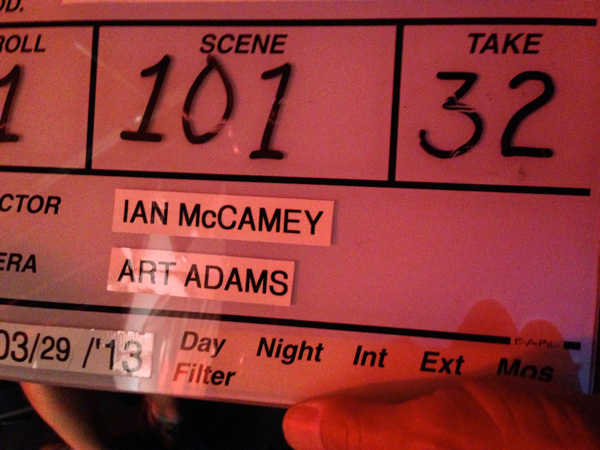
32 Takes: My First Spot with the Sony F5
Director Ian McCamey and I have done a lot of spots together, and when he calls I know he’s going to have some crazy fun idea that’s going to keep…
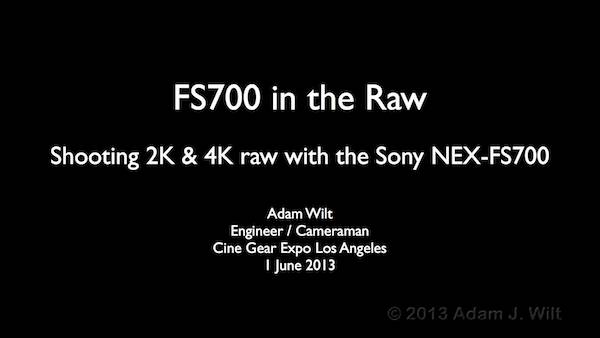
Sony NEX-FS700 in the Raw
At NAB 2013, Sony announced the raw upgrade for the NEX-FS700, allowing this $7500 camera to send raw 2K and 4K video to external recorders. In the middle of May, Sony sent me a prototype raw-enabled FS700 camera, an IFR5 raw adapter, and an AXS-R5 recorder. After ten days of frantic shooting, grading, and editing, Art and I presented “FS700 in the Raw” at Cine Gear Expo. Most of what Art discussed he’s written about here; what follows is my part of the presentation.

Review: Vinten Vision blue3 Camera Support System
The Vision blue3 is the third Camera Support System in the blue series, sitting somewhere between the original Vb, and the Vb5 I reviewed last year. The “blueBridge” Small Camera Adapter (SCA) is Vinten’s take, and an extremely well thought out one, on a Centre of Gravity (COG) lifter, a subject I talked about briefly last year in the Vb5 review. The only thing that has changed between the Vb and the Vb3 is a different spring rate. The sticks, case, spreader and head are in all respects identical down to the last detail, but for that spring change. So, if you want all the details, refer to my original Vb review. For this review of the Vision blue3, I’ll skip the usual format and concentrate on the Vb3’s place in the blue hierarchy, the measurable differences between their individual spring rates and, additionally, the effect of using the blueBridge SCA with them both.
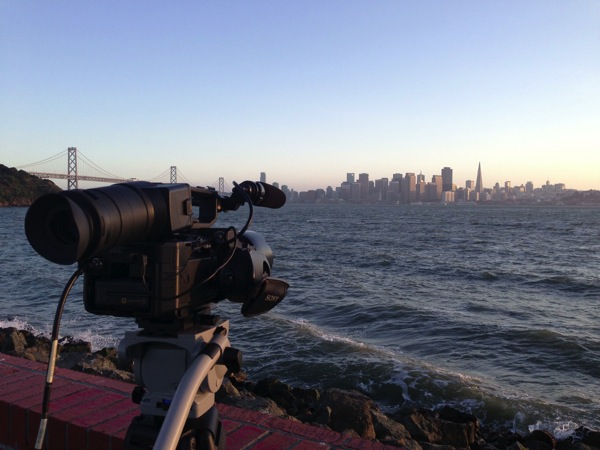
My Week Shooting 4K with an FS700 Prototype
Adam Wilt and I have had a 4K-enabled Sony FS700 to play with for a week. Come see what we’ve discovered about the latest entry into the 4K race to high resolution history. The FS700 has a lot in common with this camera — the Bell & Howell 2709 hand-cranked silent film camera (pictured right). It is 90 years old and it still works. I’m not saying that the FS700 is old or obsolete or can’t record sound; rather, I’m saying that, like the FS700, it’s possible to make beautiful images with the 2709 if you know what you’re doing. Adam and I will be presenting a 90 minute talk about shooting 4K on the FS700 this week at CineGear in Los Angeles. If you’re attending, please stop by the Sherry Lansing Theater at 2:15 on Saturday, June 1st.
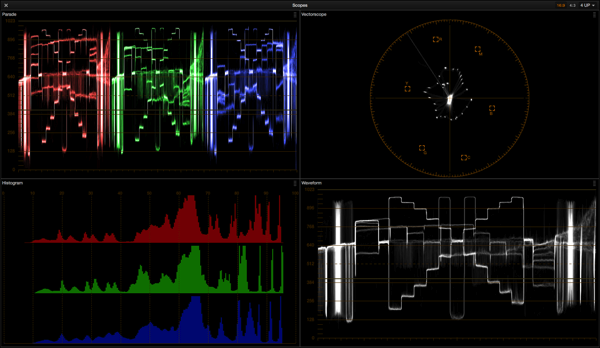
Making the Sony F55 Look “Filmic” with Resolve 9
I’ve spent a long time learning to make HD footage look “filmic” without really knowing exactly what that meant. I’ve just picked up a bit of insight, however, and it’s permanently changed how I look at video and color. I’ve shot a number of projects using an Arri Alexa in WYSIWYG mode — for which I’m considered a bit of an oddity — but with it I can get great results with no more than minimal grading and clients love walking away with ProRes files whose look is 90% there. My problem is that I now have to do this with other cameras as Alexa’s price point is considered “high” in my market due to the release of several newer, cheaper and fairly capable cameras. I love the Alexa look, but my current task is to figure out how to get close to that look when the production doesn’t have the budget to rent one — or, more likely, in the event the production company owns their own camera.

Making the Sony F55 Look "Filmic" with Resolve 9
I’ve spent a long time learning to make HD footage look “filmic” without really knowing exactly what that meant. I’ve just picked up a bit of insight, however, and it’s permanently changed how I look at video and color. I’ve shot a number of projects using an Arri Alexa in WYSIWYG mode — for which I’m considered a bit of an oddity — but with it I can get great results with no more than minimal grading and clients love walking away with ProRes files whose look is 90% there. My problem is that I now have to do this with other cameras as Alexa’s price point is considered “high” in my market due to the release of several newer, cheaper and fairly capable cameras. I love the Alexa look, but my current task is to figure out how to get close to that look when the production doesn’t have the budget to rent one — or, more likely, in the event the production company owns their own camera.
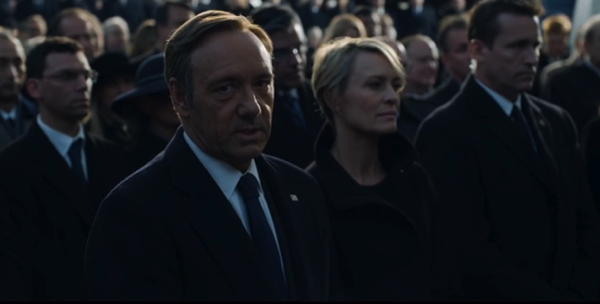
How "House of Cards" Restored My Faith That Quality Filmmaking Will Survive
Television shows with strong compositions were my earliest influences, and I’m happy to say that there’s one show on “TV” right now whose compositions move me the way my early…

How “House of Cards” Restored My Faith That Quality Filmmaking Will Survive
Television shows with strong compositions were my earliest influences, and I’m happy to say that there’s one show on “TV” right now whose compositions move me the way my early…
